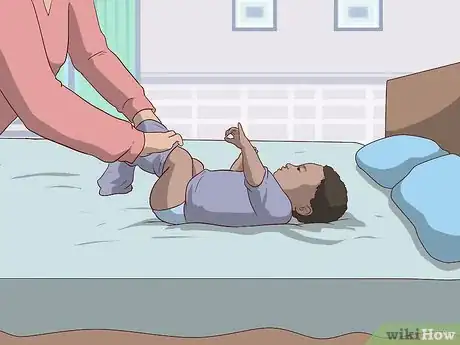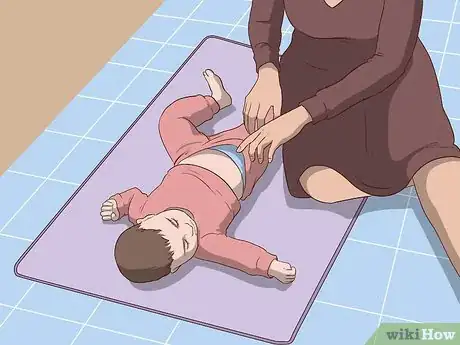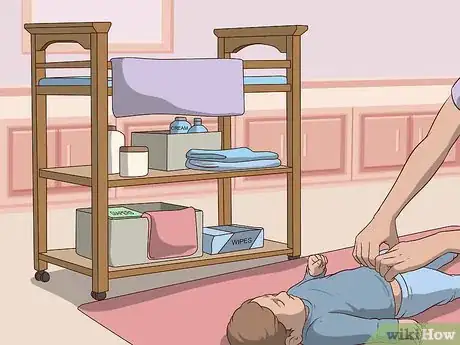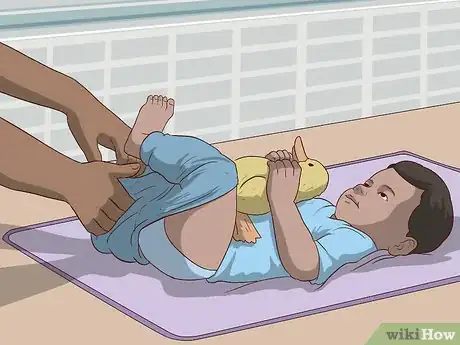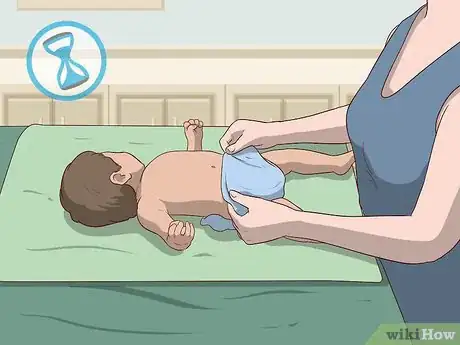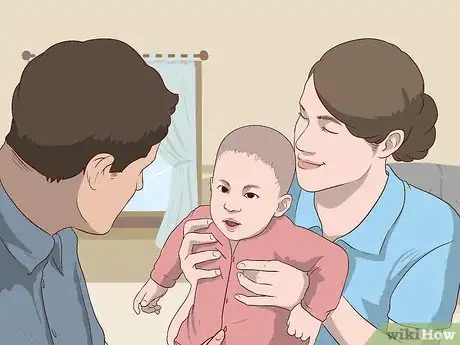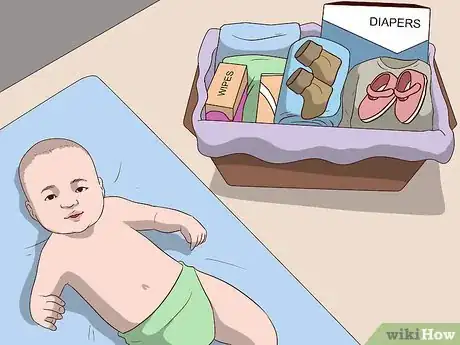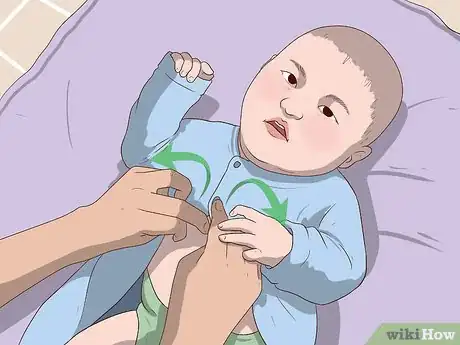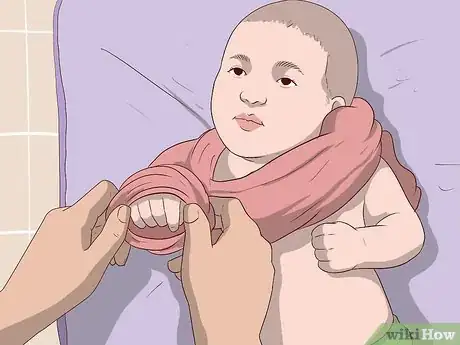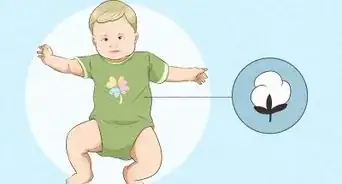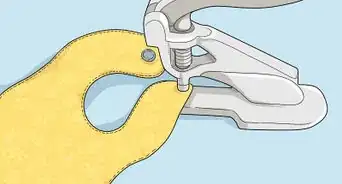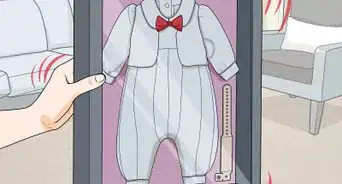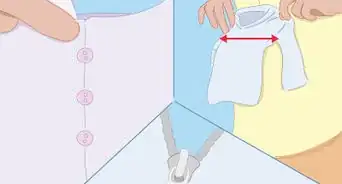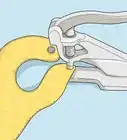This article was co-authored by Kylee Money. Kylee Money is a Parenting Consultant and the Founder and CEO of Parenting Made Joyful. Since 2001, Kylee has worked with over 1,000 parents and families on sleep training, behavior management, potty training, and more. She is a contributing writer and board advisory member at Pampers.com, a CBS News Parent Expert, and featured on Fox and Friends and Buy Buy Baby. Kylee also speaks nationally at parenting expos on the subject of sleep training.
There are 12 references cited in this article, which can be found at the bottom of the page.
This article has been viewed 19,324 times.
Some babies seem to move, wriggle, and roll over constantly, which can make it really challenging to change their diaper or clothes. Always change your baby in a safe space where they won’t be able to squirm away or accidentally fall. Distract your baby with a special toy, talk and sing to them, and work as quickly (yet as safely) as possible so the experience doesn’t last longer than it has to. Before you know it, you’ll have a fully clothed baby who is ready to eat and play!
Steps
Choosing a Safe Changing Location
-
1Use a changing table if you like to keep all your supplies in one place. A well-stocked changing table can make diaper and clothes changes more streamlined and predictable. Make sure to follow all safety precautions. Use one hand to hold your baby in place at all times and pay attention—you may need to react quickly if they start wriggling erratically! Never leave your baby on the changing station alone for any reason.[1]
- Fold-up changing mats are great to bring along with you when you’re away from home.
-
2Hold your baby in your lap to control their movements a little more. When babies are under 6 months old, it may be easier to wrestle their arms and legs into clothes if they’re sitting on your lap. Hold the baby so its back is against your chest, and gently maneuver the clothes onto the baby’s body. Make sure their neck and head are always supported.[2]
- When your baby starts crawling at around 6 months, they may still prefer to be changed while sitting in your lap. It can be a comforting experience, and your body heat may help offset the temperature difference in those moments when they aren’t into their clean clothes yet.
Advertisement -
3Lay your baby on the bed for some extra space to change their clothes. If your baby is really squirmy and you’re worried they might roll off a changing table, switch to the bed. Bring all your supplies along with you. Lay the baby on their back on the bed, and then gently start to remove their dirty clothes and put on fresh ones.[3] [4]
- If you might be changing a diaper on your bed as well as changing clothes, lay down an old towel first so that your comforter and mattress will be safe from any potential mishaps.
-
4Change your baby on the floor to eliminate the risk of them rolling away. This is a great option, too, if you’re traveling or at a friend’s home and there isn’t a changing table nearby. Lay down a blanket or towel on the floor to protect the floor and to protect your baby from any dirt or hair that might be present. Make sure there is nothing nearby that your baby could pick up and put in their mouth.[5] [6]
- If you’re at home and have a play gym or something similar, you could lay your baby underneath of it to hopefully distract them while you’re changing their diaper or clothes.
Warning: If you’re in a public space, avoid putting your baby on the floor even if you have a blanket to lay down. There are too many germs and potential dangers in a public space, and you don’t want to risk exposing your baby to them.
Changing a Diaper on a Squirmy Baby
-
1Have the diaper-changing station stocked and ready to use. Keep clean diapers, wipes, creams, and clean clothes in an easy-to-reach space. If you don’t use a changing table, keep all your supplies in a basket so that it’ll be easy to grab everything you need all at once.[7]
Don’t Forget: Wash your hands before and after you change your baby’s diaper. If you can’t wash with soap and water, use hand sanitizer; just make sure to keep the hand sanitizer out of baby’s reach.
-
2Use humor to get the baby in a happy mood. If you can, take 2 to 3 minutes to play with, sing to, and interact with your baby before changing their diaper (if they’re screaming or need to be changed ASAP, you obviously might not have the luxury to do this). Getting them into a good mood before changing their diaper could help them calm down a little, and it could turn into a bonding moment for the two of you.[8]
- Even as you change the diaper, continue talking to your baby and interacting with them.
-
3Give your baby a toy to distract them while you’re changing their diaper. Pick something that your baby doesn’t play with on a daily basis so that it will really capture their interest. Items that are bright in color, crinkly, reflective, or loud are great options that will captivate and distract your baby. Just make sure the item is baby-safe and that they won’t be able to accidentally swallow or choke on it.[9] [10]
- Depending on your child, you may need to introduce new toys every few days. Have a small basket beside the changing station that is stocked with options to make changing time even easier.
-
4Change the baby’s diaper as fast as you can. Babies generally dislike those brief 30 seconds while their bottom is exposed, the temperature changes, and their body is being moved around. Make the experience as quick and as pleasant as possible to reduce the wriggling. Of course, make sure to thoroughly clean your baby and apply any necessary creams or ointments![11] [12]
- When you’re first starting to change diapers on a newborn baby, it may take you a little while to get the hang of things. Don’t worry! The more you practice (and you’ll have dozens of opportunities to practice every day) the more efficient you’ll become at diaper changing.
Putting New Clothes on Your Baby
-
1Remember that it’s normal and good for your baby to move. It may be super frustrating to feel like you’re battling your baby every time you try to change their clothes; try to keep in mind that their movements and desire to explore are healthy. Sometimes, depending on just how squirmy your baby is, you may not be able to get every single snap and button secured when you change their clothes. Just fasten enough of the outfit so that it stays in place and make adjustments later when your baby is calmer.[13]
- If you do get overwhelmed, it’s okay to ask for help, too. If you have a partner or older kids, they can help with some of the responsibilities. If you don’t have anyone else to help in the home and can afford to do so, consider hiring a nanny to come in for a few hours once a week so you can have a break.
-
2Gather all the clothes you’ll need beforehand so it’s all in one place. When you’re working with a squirmy baby, the last thing you want is to have to stop in the middle of the process to find a top or a pair of pants you forgot. Babies can work their way out of unfastened clothes really quickly! Grab a full outfit (onesie, pants, sweater, hat, socks, etc.) before you even get your child.[14]
- Keeping an organized closet or dresser filled with baby clothes will really help you streamline this process.
-
3Undo all buttons, snaps, and zippers and remove dirty clothes gently. Part of what makes changing your baby’s clothes so tedious is that you also have to get them out of their old clothes before you can put fresh ones on. Make this easier on yourself by completely unfastening anything that can be undone before you even attempt to remove an article of clothing. Once everything is undone, gently pull the clothing off of each limb individually, taking care to not move too fast or accidentally twist your baby’s arms or legs.[15]
- Avoid roughly pulling clothes over your baby’s face—if you need to pull something over their head, gather the fabric into a large ring and stretch it over their face so it doesn’t catch on their mouth, nose, or eyes.
-
4Compress fabric in an accordion-like shape so it’s easier to put on. For example, if you’re putting a long-sleeved onesie onto your baby, scrunch up the material of one of the arms so that you can easily fit your fingers through the armhole. Then gently grab your baby’s hand and slide the entire sleeve over their fist at once. This prevents your baby’s hand from getting stuck at a weird angle in the sleeve, and it’ll make the changing process go much faster.[16]
- You can do this for arms, legs, and the neck of garments, too. Most baby clothes are made of soft, stretchy fabric, so it shouldn’t damage anything to stretch and compress them like this.
-
5Support your baby’s head if you need to lift them while dressing them. Certain outfits might require you to pick your baby up at some point to fasten something behind them or to put on an outfit that fastens in the front. When this happens, make sure to pick them up like you normally would while supporting their head and neck. Don’t pick them up from their middle if they’re too young to support their head themselves.[17]
Did You Know: It’ll be about 6 months before your baby will be able to lift their head on their own when they’re in a seated position.
-
6Talk to your baby and interact with them while you’re changing them. Sing songs, make chatter, and engage with your baby throughout the changing process. Giving them a toy could be helpful, but it also could make it harder to put on their clothes if you can’t fit the clothing over the toy or if the baby refuses to let go of the item.[18]
- If your baby is super squirmy and is “dancing” around on the table, put on some music! Make changing time into a fun experience that both you and the baby can look forward to.
Community Q&A
-
QuestionWhat if my baby is over a year old?
 Community AnswerThe advice given in this article would most likely still apply to your situation.
Community AnswerThe advice given in this article would most likely still apply to your situation.
References
- ↑ https://americanpregnancy.org/first-year-of-life/changing-a-diaper/
- ↑ https://www.healthychildren.org/english/ages-stages/baby/diapers-clothing/pages/dressing-your-newborn.aspx
- ↑ https://americanpregnancy.org/first-year-of-life/changing-a-diaper/
- ↑ Kylee Money. Parenting Consultant. Expert Interview. 21 May 2021.
- ↑ https://www.babycentre.co.uk/a25004911/parents-tips-should-i-buy-a-changing-table
- ↑ Kylee Money. Parenting Consultant. Expert Interview. 21 May 2021.
- ↑ https://www.everydayfamily.com/slideshow/5-tips-get-squirmy-baby-diaper-change/#
- ↑ https://youtu.be/qbkFSyzVU_4?t=329
- ↑ https://youtu.be/qbkFSyzVU_4?t=59
- ↑ Kylee Money. Parenting Consultant. Expert Interview. 21 May 2021.
- ↑ https://youtu.be/qbkFSyzVU_4?t=291
- ↑ Kylee Money. Parenting Consultant. Expert Interview. 21 May 2021.
- ↑ https://youtu.be/9cW4AShjdzM?t=116
- ↑ https://www.healthychildren.org/english/ages-stages/baby/diapers-clothing/pages/dressing-your-newborn.aspx
- ↑ https://youtu.be/-31dtweZN8s?t=43
- ↑ https://youtu.be/9cW4AShjdzM?t=33
- ↑ https://youtu.be/9cW4AShjdzM?t=65
- ↑ https://youtu.be/qbkFSyzVU_4?t=329


